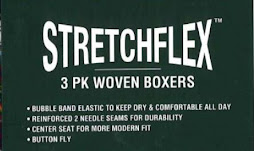TTABlog Test: Are Protective Clothing and Sporting Gear Related to Underwear and Loungewear for Section 2(d) Purposes?
The USPTO refused to register the mark PFANNER STRETCHFLEX for various items of protective clothing (e.g., accident, radiation and fire protection garments) and protective sporting gear (e.g., athletic protective shin, knee, back and elbow pads for playing sportse), finding confusion likely with the registered mark STRETCHFLEX for underwear and loungewear. The Board found the marks to be similar in appearance, sound, connotation and commercial impression. But what about the goods? Is relatedness too much of a stretch? In re Pfanner Schutzbekleidung GmbH, Application Serial No. 79247130 (August 5, 2021) [not precedential] (Opinion by Judge Marc A. Bergsman).
The Marks: The Board found the term "stretchflex" to be suggestive of a desirable characteristic of registrant's goods, but "it is not necessarily a weak term entitled to only a limited scope of protection." Comparing the marks, the Board noted that there is no per se rule that when an applicant incorporates the whole of the cited mark, the marks must be found to be similar. However, it does increase the perception that the marks are similar.
Applicant claimed that PFANNER is the dominant term in its mark because it appears first and because STRETCHFLEX is weak. The Board rejected the weakness arguments, and it pointed out that consumers may perceive the addition of the corporate name PFANNER as indicating the previously anonymous source of the STRETCHFLEX products.
As mentioned above, the Board found the marks to be similar in appearance, sound, connotation, and commercial impression.
The Goods: To show the relatedness of the goods, the Examining Attorney relied on several websites (including Carhartt, Under Armour, Adidas, and Nike) showing "the same mark used to identify the relevant products." The Board was not impressed, noting that the Examining Attorney did not submit any third-party registrations for marks covering both types of goods.
Two examples of entities selling both protective clothing and underwear or loungewear as their core product lines, and three examples of entities selling both protective sporting gear and underwear or loungewear is not sufficient to prove protective clothing and protective sporting gear are related to underwear or loungewear.
The Board concluded that the Examining Attorney failed to prove the relatedness of the goods, and so, it reversed the refusal.
Read comments and post your comment here.
TTABlogger comment: The Examining Attorney must have thought that those big name websites were enough proof of relatedness. I probably would have thought the same.
PS: I suppose if you sleep on a bed of nails, you might wear protective loungewear.
Text Copyright John L. Welch 2021.


4 Comments:
"The Board found the term "stretchflex" to be suggestive of a desirable characteristic of registrant's goods, but "it is not necessarily a weak term entitled to only a limited scope of protection."
I can't get over this part. Stretch and flex aren't weak in underwear? Obviously, they are.
Genuine websites have less weight than registrations in showing relatedness of goods??
Isn't that backwards from what the TTAB and CAFC usually hold as to what weight to give those two forms of evidence?
Just once I would like to see, "The examiner introduced evidence that he asked a random dude on the street whether protective clothing and loungewear are related, and the random dude said, 'They're both clothes, right?'"
Agree with your comment and this decision seems to counter those in many similar scenarios.
Post a Comment
<< Home